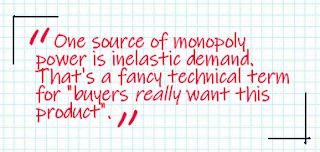Fundamentals: Monopoly Power
Definitions
Technical definition: Monopoly power is the ability of a seller to push the market price of their product above their marginal cost (MC). (Source: Xplaind.com)
Non-Technical Definition: The ability of a firm to influence the price at which it sells its product.
Commentary
Folks who haven't studied Economics (and even many who have) often stumble over the concept of monopoly power. It's easy to see why -- it sounds like a superpower that should belong exclusively to the monopolist.
In fact, it's not exclusive to the monopolist and it can be very useful to learn about and study. Monopoly power is all around us, every day.I should point out here that "monopoly power" is synonymous with "market power". I also want to point out that the field of Law has it's own definition of "monopoly power" that may not correspond exactly with that of the field of Economics. Here we are only discussing the definition(s) used in the field of Economics.
The roots of Monopoly Power
One source of monopoly power is inelastic demand. That's a fancy technical term for "buyers really want this product".
Are you up for a little technical drill-down here? Price elasticity of demand is the percentage change in quantity demanded per percentage change in price. Written as an equation it looks like this:
E = %ΔQuantity / %ΔPrice
Sharp nerds will note that this isn't simply the slope of the demand curve, but something a bit different. But we don't need to understand elasticity of demand in depth to understand how an inelastic demand curve yields some degree of monopoly power for the seller.
We only need to understand this: An inelastic demand curve is one like that of gasoline or cigarettes. If the price of gasoline goes up by 50%, most of us will buy perhaps 8% less gas. Likewise if the price of cigarettes increases by, say, 30%, the nicotine-addicted smoker may only react by purchasing 5% fewer cigarettes.
In contrast, the demand for celery or oatmeal is probably very elastic -- if the price of celery goes up by 50%, I would probably buy 100% less celery.So, you might think of products with inelastic demand as those that are either addictive, compelling, or have a certain allure to them (like Reese's Peanut Butter Cups).
And therein lies to root of monopoly power: The seller can jack the price without risking a corresponding loss of sales.
How can we spot it?
On the spectrum of market types, monopoly power begins to enter the picture with monopolistic competition. Any time one seller begins to invest in branding or advertising with claims like "My product is better than the others!" then we could reasonably infer that they are exercising monopoly power. (If they weren't confident their branding or advertising investment could influence the price of their product, they probably wouldn't invest the resources to advertise this claim.)
Barriers to Entry in a market generate monopoly power for all sellers in that market. For better or worse, intentionally or unintentionally, barriers to market entry put upward pressure on the price of a product and all sellers in that market enjoy the monopoly power created by these barriers. Some examples of markets that have barriers to entry in the US are: doctors, lawyers, nuclear power plants, bars, restaurants, commercial kitchens (double barrier if your kitchen serves dairy products), even hair stylists. All of these markets require some sort of examination and licensing to sell in.
In many cases, sellers who enjoy monopoly power due to barriers to entry will also invest in branding and advertising to maximize their monopoly power.
Only in cases where monopoly power becomes severely anti-competitive do firms expose themselves to legal liability. This is usually limited to cases where a firm is blocking other firms from entering their market or engaging in cartel behavior (such as collusion / coercion). However, illegal monopoly behavior is not within the scope of this article.






Comments
Post a Comment